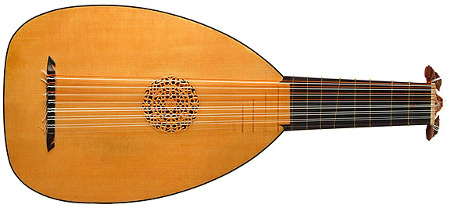
Even non-musicians are generally familiar with the guitar and the many forms and shapes it takes. The guitar likely evolved from the lute to give us the modern design we see frequently today.As a guitar player, I rarely had to deal with the issue of explaining what my instrument was to people I met.
Instruments like a lute full#
The first guitar came from Spain in the 19th century – a full ten centuries after the first known lute. The lute also comes with a much longer, richer history than guitars. If you are a person with smaller hands who finds the size of guitars to be intimidating, the lute may provide you with a style of instrument more up your alley. Guitars tend to be larger, with longer necks and more frets. They also have shorter necks that may or may not have frets. The average lute will have eight courses containing 15 strings.Īlthough the general design of the lute and guitar are similar, lutes typically have deeper, rounder bodies. The average guitar uses just six strings, while a lute can have as many as 24 strings in sets (called courses) of two. One of the main differences between the two is the number of strings. While the lute and the guitar are similar instruments that use strings, frets, and pegboxes to play and tune, the two have some significant differences. Today, musicians and historians alike have revived the instrument. Bach himself owned a lute and arranged for the instrument as well.īut after his death, the popularity of the instrument began to diminish, and the 19th century saw the lute all but disappear. Throughout the centuries to come, the lute would reach peak popularity in several countries: first France, then Italy, and finally, Germany in the 18th century. It was the perfect solo instrument for a masterful performance. It was frequently used to play secular music during the Renaissance, where it got played to entertain kings and queens, as musical theater in many plays – including Shakespeare – and was enjoyed by commoners on the street.īut why was the lute so revolutionary? With the addition of many more strings, musicians discovered that plucking the strings using multiple fingers allowed them to follow several lines of music at once. The lute quickly became a crucial instrument from the Medieval era to the late Baroque period. The instrument went from four courses to 13. The most prevalent change was usually to the courses or the pair of strings. Lutes continued to appear from the 13th century onward, enduring many changes along the way. Later, in the 13th century, the Western lute became more distinctive. This Arab instrument can be confidently dated back to the 9th century thanks to carvings and paintings. However, many experts believe it is closely related to the ‘ud, an Arab string instrument boasting a similar pear-shaped body and decorative soundholes. The History Of The Luteīecause the lute has been around for such a long time, it’s tough to nail down the exact history of the instrument. You can change the notes by switching your finger positions on your left hand. Beginners will likely pluck with their index finger and thumb, but advanced players can pluck several strings using all their fingers. Beginners will find it best to play seated where they can rest the body of the lute on their thighs.įrom here, a musician will use their left hand to control the notes, while your right hand will pluck the strings across the body of the lute. The easiest way to play the lute is to use a strap and wear it over your shoulders. You can tune the lute by twisting each peg until the strings sound as they should. Lutes have at least six pegs, though they will have more if there are more sets of strings. How Do You Play The Lute?Ī musician must begin by tuning the lute using the pegs on the pegbox. More complex lutes can have 13 sets of two strings on the arm, while beginner versions have just six.

They connect to the bridge at the bottom of the body. They run from the pegbox, down the neck, and across the body of the lute. The strings on a lute function just like those on a guitar.

Musicians twist the pegs to tighten or loosen the strings, thus tuning the pitch of each set. At the end of the neck is the pegbox, which holds all of the strings using pegs. The base of the lute connects to a neck which contains the fingerboard and frets.

The flat side of the body is called the soundboard, and it has a patterned cutout that echoes and amplifies the sound throughout the instrument’s body. The body of a lute is round and deep, helping give the instrument its unique sound. Much like a guitar, a lute has a hollow base made of thin strips of wood called the body. A lute is an instrument from the string family.


 0 kommentar(er)
0 kommentar(er)
